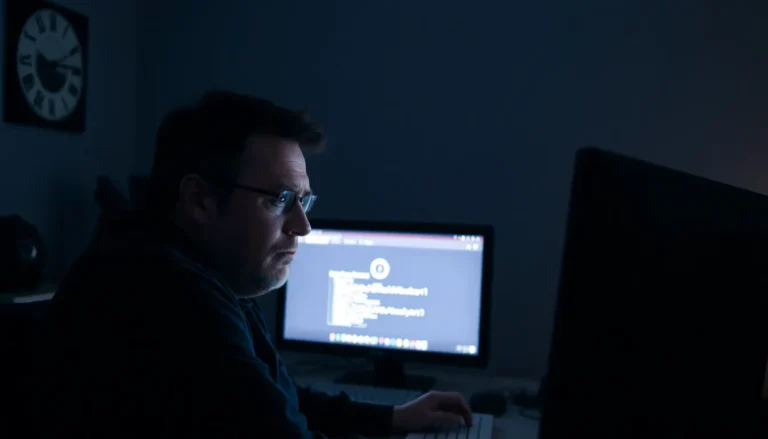Table of Contents
ToggleIn a world where creativity meets technology, careers in the arts, audio/video technology, and communications offer a thrilling ride. Imagine waking up every day to a job that combines your passion for storytelling with cutting-edge tech. Whether it’s crafting mesmerizing visuals or producing the next viral podcast, this career cluster is a playground for innovative minds ready to make their mark.
Overview of Careers in the Arts, Audio/Video Technology, & Communications Career Cluster Include
Careers in the arts, audio/video technology, and communications offer diverse opportunities for creative and tech-savvy individuals. Roles in this sector include graphic designers, who create visual content for print and digital media. Sound engineers manage audio recordings and ensure high sound quality in various settings.
Several job titles exist within the realm of video production. Videographers capture footage for films, commercials, and events. Editors refine video content, adding special effects and delivering polished final products.
Multimedia artists and animators use software to produce animations and visual effects for television, movies, and video games. They blend artistic vision with technical skills to engage audiences.
Public relations specialists foster a positive public image for organizations through strategic communication efforts. Their work encompasses writing press releases and managing social media accounts.
Journalists in the communications cluster gather and report news stories across multiple platforms. They research topics, conduct interviews, and deliver factual information to the public.
Advertising professionals develop campaigns to promote products and services. Their roles often involve collaborating with creative teams to produce compelling advertisements.
Career advancement opportunities abound in this cluster. Networking events, workshops, and internships provide valuable experience and connections. Specializing in emerging technologies or niches enhances job prospects in these dynamic fields.
Innovative thinkers thrive in careers that merge artistry and technology. Passion for creativity and effective communication drives success in the arts, audio, video technology, and communications sectors.
Key Industries and Sectors

Careers in the arts, audio/video technology, and communications encompass various industries that blend creativity with technical expertise. Each sector contributes significantly to the cultural and informational landscape.
Performing Arts
Performing arts include theater, music, and dance. Actors, musicians, and dancers play vital roles in live performances, showcasing their talents to engage audiences. These professionals often collaborate with directors and choreographers to create compelling productions. Many individuals work behind the scenes, too, including stage managers and lighting technicians, ensuring that every performance runs smoothly. Opportunities exist in venues like theaters, concert halls, and festivals, driving artistic expression and community connection.
Visual Arts
Visual arts cover a broad spectrum, from painting and sculpture to digital design. Artists create visually captivating works that inspire and provoke thought. Graphic designers and illustrators use their skills to communicate ideas through imagery, while photographers capture moments that tell unique stories. Various sectors utilize visual arts, including advertising, fashion, and education. Each visual artist engages with audiences in distinct ways, whether through public exhibitions or personal portfolios.
Media Production
Media production encompasses film, television, and digital content creation. Professionals in this sector include directors, producers, and editors, who bring stories to life through compelling visuals and sound. Videographers and cinematographers capture stunning footage, while sound engineers ensure audio quality. This industry experiences constant evolution with technology advancements, allowing new formats and platforms to emerge. Career paths in media production often require collaboration with other creatives, providing a dynamic work environment.
Communication Services
Communication services include public relations, advertising, and journalism. Each role plays a critical part in shaping public perception and delivering information. Public relations specialists manage brand reputations, while advertising professionals create campaigns that engage consumers. Journalists investigate and report news, often under tight deadlines. Effective communication remains essential across sectors, requiring strong writing and interpersonal skills. Networking and collaboration are key elements in navigating this competitive landscape.
Essential Skills and Qualifications
Success in careers within the arts, audio/video technology, and communications demands specific skills and qualifications. Individuals pursuing these fields benefit from a clear understanding of educational pathways, technical abilities, and essential soft skills.
Educational Requirements
Most careers in this cluster require a bachelor’s degree in a related field. Graphic designers and multimedia artists often study visual arts or design, while sound engineers and videographers typically delve into audio or media production. Public relations specialists and journalists often pursue communications or journalism degrees. Some positions may accept an associate degree or equivalent experience. Additional certifications in specialized software or techniques enhance job prospects.
Technical Skills
Proficiency in industry-standard software is crucial for many roles. Graphic designers need expertise in Adobe Creative Suite, while videographers benefit from skills in Final Cut Pro or Adobe Premiere. Understanding sound design and mixing tools, such as Pro Tools or Logic Pro, is essential for sound engineers. Familiarity with digital marketing tools can boost the effectiveness of communication specialists. Technological adaptability proves valuable as the industry continuously evolves.
Soft Skills
Creativity stands as a cornerstone in this career cluster, allowing individuals to produce innovative content. Communication skills enhance collaboration and audience engagement. Problem-solving abilities enable professionals to navigate challenges effectively. Time management plays a significant role, especially in meeting tight deadlines. Networking skills facilitate valuable connections in the industry, strengthening career opportunities.
Career Pathways and Opportunities
The arts, audio/video technology, and communications career cluster offers diverse pathways for aspiring professionals. A combination of creativity and technical skill can lead to numerous opportunities.
Entry-Level Positions
Entry-level roles often serve as stepping stones in this vibrant sector. Positions such as graphic design assistants, audio technicians, and junior editors provide hands-on experience. Graduates can enhance their resumes through internships and workshops that focus on industry-standard software. Networking assists new professionals in connecting with mentors in their field. Many companies seek individuals who are eager to learn and grow within the industry.
Advanced Career Options
Advanced roles present exciting challenges and responsibilities. Creative directors, senior producers, and lead animators often shape significant projects. Professionals in these positions typically leverage years of experience and a robust portfolio to secure opportunities. Continuing education and mastering emerging technologies can enhance career prospects in this fast-changing landscape. Acquiring specialized skills, such as augmented reality or data visualization, becomes increasingly important for advancement.
Freelancing and Entrepreneurship
Freelancing offers flexibility and independence for creative professionals. Many individuals choose to build their brands by offering services directly to clients. Success requires strong project management and communication skills, as freelancers juggle multiple tasks. Starting a design studio or a production company can be appealing for those with entrepreneurial spirit. Establishing a solid online presence and cultivating a network expands opportunities for freelancers in the arts and communications arena.
Future Trends in the Career Cluster
New technologies continue to reshape the arts, audio/video technology, and communications career cluster. Virtual reality (VR) and augmented reality (AR) are gaining prominence, enabling immersive storytelling experiences. These technologies create opportunities for professionals to engage audiences in innovative ways, altering traditional media formats.
Artificial intelligence (AI) starts to enhance creative processes, from generating content to automating editing tasks. Many professionals leverage AI to streamline workflows, allowing for quick adjustments without compromising quality. This approach creates space for more creativity as repetitive tasks become automated.
Social media platforms evolve, driving demand for content creators skilled in various formats, including video, graphics, and podcasts. Engaging audiences across platforms requires adaptability and knowledge of current trends. Professionals must stay abreast of shifts in audience preferences to maintain relevance.
Sustainability emerges as a crucial focus within the arts and media sectors. Creatives prioritize eco-friendly practices in production, influencing everything from materials used to energy consumed. This trend resonates with audiences, driving support for brands that align with sustainable values.
Freelancing opportunities expand, with remote work becoming commonplace in various roles. Professionals value the ability to work on diverse projects, allowing for personal and professional growth. Networking remains vital, as connections often lead to new projects and collaborations.
Emerging fields, such as influencer marketing and interactive media, attract talent interested in groundbreaking strategies. These areas focus on building genuine connections with audiences through creativity and innovation. Professionals find ways to harness these trends, ensuring continued career advancement in a competitive environment.
The career cluster of arts, audio/video technology, and communications continually evolves, presenting fresh opportunities and challenges for aspiring creatives. Staying informed about technological advancements and market trends helps professionals thrive in this dynamic landscape.
Careers in the arts, audio/video technology, and communications offer a vibrant landscape for creative individuals. This dynamic sector not only celebrates artistic expression but also embraces technological advancements that shape storytelling. As professionals navigate diverse roles from graphic design to multimedia production, they contribute significantly to how audiences engage with content.
The emphasis on networking and continuous learning ensures that aspiring creatives remain competitive in an ever-evolving industry. With emerging trends like virtual reality and artificial intelligence, the future holds exciting possibilities for innovation. Those passionate about creativity and communication will find ample opportunities to thrive in this fascinating career cluster.






